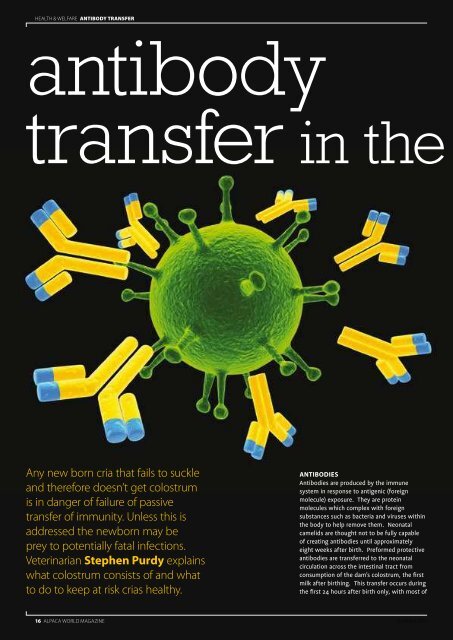You also want an ePaper? Increase the reach of your titles
YUMPU automatically turns print PDFs into web optimized ePapers that Google loves.
health & welfare antibody transfer<br />
health & welfare antibody transfer<br />
antibody<br />
transfer in the neonatal<br />
camelid<br />
Any new born cria that fails to suckle<br />
and therefore doesn’t get colostrum<br />
is in danger of failure of passive<br />
transfer of immunity. Unless this is<br />
addressed the newborn may be<br />
prey to potentially fatal infections.<br />
Veterinarian Stephen Purdy explains<br />
what colostrum consists of and what<br />
to do to keep at risk crias healthy.<br />
Antibodies<br />
Antibodies are produced by the immune<br />
system in response to antigenic (foreign<br />
molecule) exposure. They are protein<br />
molecules which complex with foreign<br />
substances such as bacteria and viruses within<br />
the body to help remove them. Neonatal<br />
camelids are thought not to be fully capable<br />
of creating antibodies until approximately<br />
eight weeks after birth. Preformed protective<br />
antibodies are transferred to the neonatal<br />
circulation across the intestinal tract from<br />
consumption of the dam’s colostrum, the first<br />
milk after birthing. This transfer occurs during<br />
the first 24 hours after birth only, with most of<br />
the transfer occurring within the first 12 hours.<br />
It is therefore important that the consumption<br />
of antibody rich colostrum occurs shortly after<br />
birth. These antibodies are what protect the<br />
cria from disease while its immune system is<br />
developing.<br />
All immunoglobulins share a basic<br />
structure (figure 1) except camelids and a<br />
few other unrelated species (notably sharks).<br />
The antibodies of major importance in<br />
camelid colostrum are all of the IgG class<br />
(immunoglobulin G). Of three identified so far,<br />
IgG1 has the classical structure and IgG2 and<br />
IgG3 have the heavy chain antibody structure.<br />
IgG1 is the one present in the largest quantity<br />
(Daley, 2007).<br />
Colostrum antibody levels depend on the<br />
immune system competence of the dam, as in<br />
does her immune system respond to foreign<br />
substances The dam’s specific environmental<br />
challenges also determine what antibodies<br />
she produces. Colostrum is also an excellent<br />
source of nutrition for the neonate in addition<br />
to providing the cria with these preformed<br />
antibodies. Colostrum from other species<br />
(most commonly from goats or cows) may<br />
be used if the dam has no milk. Colostrum<br />
quality depends on the level of antibodies<br />
in the dam’s milk. The concentration of IgG<br />
in alpaca colostrum decreases rapidly in the<br />
Figure 1: (a) <strong>Classical</strong> structure of antibodies and (b)<br />
heavy-chain antibody structure. (L = light molecular<br />
weight; H = heavy molecular weight;<br />
V = variable region; C = constant region)<br />
first 24 hours (Daley, 2007). Consumption<br />
depends on the nursing of the cria and<br />
amount of milk produced by the dam. Slow<br />
or premature crias or reluctant mothers will<br />
decrease that. Absorption of antibodies also<br />
depends on early consumption by the cria<br />
before the gut becomes impervious to large<br />
protein molecules. Interference at any step<br />
in the process will affect the antibody level in<br />
the cria and increase the risk of infection, as<br />
these maternally derived antibodies are used<br />
for protection while the cria’s own immune<br />
system undergoes maturation during the first<br />
two months of life.<br />
16 Alpaca World Magazine<br />
summer 2010<br />
summer 2010<br />
Alpaca World Magazine 17







